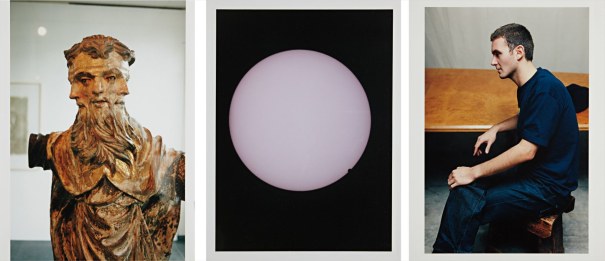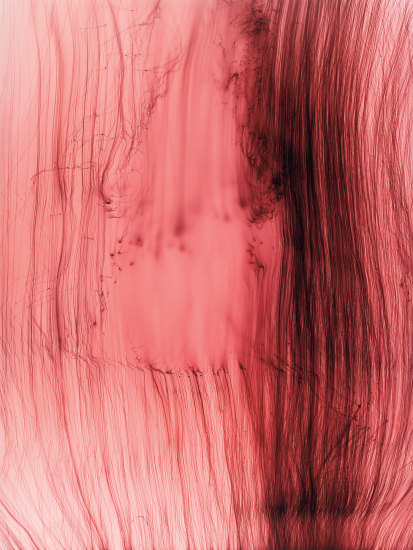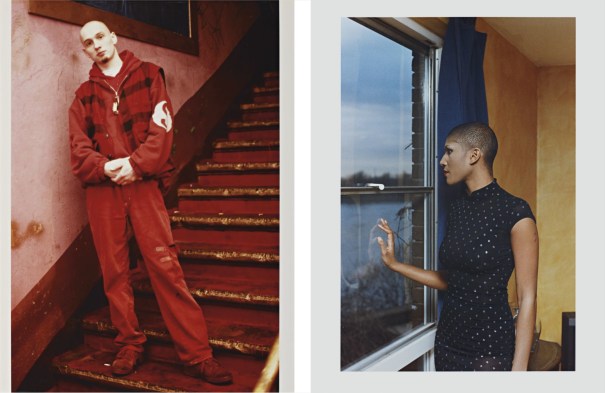Wolfgang Tillmans Follow Greifbar 27 signed and numbered 'Wolfgang Tillmans 1/1 +1' on a label affixed to the reverse chromogenic print mounted on aluminium, in artist's frame 240 x 181 cm (94 1/2 x 71 1/4 in.) Executed in 2014, this work is number 1 from an edition of 1 plus 1 artist's proof.
Provenance Terre des Femmes Charity Auction, Berlin, 18 April 2016, lot 23 (gifted by the artist) Acquired at the above sale by the present owner Catalogue Essay Greifbar 27 is an exquisite example of the 2000 Turner Prize winner Wolfgang Tillmans’ series of abstractions that challenge the traditional gestural means of representation. Manipulating light he composes camera-less photographs. Caught between chance and the artist's intervention, Tillmans commenced his celebrated body of abstract works in 2003. The first work from the titled series, Greifbar 1, won the artist the prestigious Wooliston prize at the Royal Academy’s summer exhibition in 2014. Tillmans’ abstract compositions have been included in two recent monumental solo exhibitions at Tate Modern in London and the Fondation Beyeler in Riehen. Each show highlighted the artist’s increasing international importance and the critical acclaim with which his immense photographic experimentations have been received. Exposing undeveloped photographic paper to light, Tillmans manipulates and skilfully directs light to form his camera-less compositions. At first glance, the non-representational composition seems almost scientific. One appears to be observing evidence derived from natural processes, despite the fact that Greifbar 27 has been created by the artist’s own gestures in space. Concerned with the concept engrained in the perception of his abstract works, Tillmans values the importance of reading the compositions as a photograph, rather than a brushstroke. ‘It is important that these are not paintings, as the eye recognises these as photographic the association machine in the head connects them to reality, whereas a painting is always understood by the eye as mark making by the artist’ (Wolfgang Tillmans quoted in Dominic Eichler, 'Interview with Wolfgang Tillmans', Wolfgang Tillmans Abstract Pictures , Ostfildern, 2011, p. 24). A continuation of the Freischwimmer and Einzelgänger series, Tillmans uses light to form arabesque-like lines, thereby creating seductive works of art. Where the Freischwimmer series is created through a completely dry process, in the Greifbar series the artist employs new means to disrupt the image, adding chemicals onto the plane. In line with his still lifes, landscapes and portraits, Tillmans’ abstract works challenge our preconceived perceptions of photography, the artist questions the authenticity and objective reading of the medium. The gestural and deep blue composition evokes the motion and action intrinsic to Yves Klein’s Anthropométries, his living paintbrushes. In tonality, motion and experiment, the present work echoes the Abstract Expressionist’s pioneering modernist and erratic compositions. In line with Klein’s body of Anthropométries, the present work is enchanting in its contemplative and gestural hues. Both artists subvert the medium, commanding a reading free from ideology and challenging conventional modes of creation. Tillmans’ works are intensely connected to life experiences, the deep blue streaks and fine lines are reminiscent of ink dissolving in water; the vast fields of tonal blues fuse with the fine darker lines. Greifbar , meaning tangible, reflects the artist’s reference to figuration in the series of abstractions. The thin strands of intensive colour extend across the lighter background, varying in their sharpness they enhance the viewer’s perception as they attempt to focus. A later work from the consecutively numbered series, Greifbar 29 adorned the cover of Tillmans’ widely acclaimed 2017 solo exhibition at Tate Modern in London. In these works Tillmans does not aim to depict reality, but rather thought: ‘It's about the transformation that conceptual photography and conceptual art have in common: the transformation of a thought’ (Wolfgang Tillmans quoted in Susanne Schreiber, 'Die Idee der Schönheit ist politisch', Handelsblatt, 13 July 2017, online). Echoing Sigmar Polke’s Dispersion photographs, Tillmans’
Wolfgang Tillmans Follow Greifbar 27 signed and numbered 'Wolfgang Tillmans 1/1 +1' on a label affixed to the reverse chromogenic print mounted on aluminium, in artist's frame 240 x 181 cm (94 1/2 x 71 1/4 in.) Executed in 2014, this work is number 1 from an edition of 1 plus 1 artist's proof.
Provenance Terre des Femmes Charity Auction, Berlin, 18 April 2016, lot 23 (gifted by the artist) Acquired at the above sale by the present owner Catalogue Essay Greifbar 27 is an exquisite example of the 2000 Turner Prize winner Wolfgang Tillmans’ series of abstractions that challenge the traditional gestural means of representation. Manipulating light he composes camera-less photographs. Caught between chance and the artist's intervention, Tillmans commenced his celebrated body of abstract works in 2003. The first work from the titled series, Greifbar 1, won the artist the prestigious Wooliston prize at the Royal Academy’s summer exhibition in 2014. Tillmans’ abstract compositions have been included in two recent monumental solo exhibitions at Tate Modern in London and the Fondation Beyeler in Riehen. Each show highlighted the artist’s increasing international importance and the critical acclaim with which his immense photographic experimentations have been received. Exposing undeveloped photographic paper to light, Tillmans manipulates and skilfully directs light to form his camera-less compositions. At first glance, the non-representational composition seems almost scientific. One appears to be observing evidence derived from natural processes, despite the fact that Greifbar 27 has been created by the artist’s own gestures in space. Concerned with the concept engrained in the perception of his abstract works, Tillmans values the importance of reading the compositions as a photograph, rather than a brushstroke. ‘It is important that these are not paintings, as the eye recognises these as photographic the association machine in the head connects them to reality, whereas a painting is always understood by the eye as mark making by the artist’ (Wolfgang Tillmans quoted in Dominic Eichler, 'Interview with Wolfgang Tillmans', Wolfgang Tillmans Abstract Pictures , Ostfildern, 2011, p. 24). A continuation of the Freischwimmer and Einzelgänger series, Tillmans uses light to form arabesque-like lines, thereby creating seductive works of art. Where the Freischwimmer series is created through a completely dry process, in the Greifbar series the artist employs new means to disrupt the image, adding chemicals onto the plane. In line with his still lifes, landscapes and portraits, Tillmans’ abstract works challenge our preconceived perceptions of photography, the artist questions the authenticity and objective reading of the medium. The gestural and deep blue composition evokes the motion and action intrinsic to Yves Klein’s Anthropométries, his living paintbrushes. In tonality, motion and experiment, the present work echoes the Abstract Expressionist’s pioneering modernist and erratic compositions. In line with Klein’s body of Anthropométries, the present work is enchanting in its contemplative and gestural hues. Both artists subvert the medium, commanding a reading free from ideology and challenging conventional modes of creation. Tillmans’ works are intensely connected to life experiences, the deep blue streaks and fine lines are reminiscent of ink dissolving in water; the vast fields of tonal blues fuse with the fine darker lines. Greifbar , meaning tangible, reflects the artist’s reference to figuration in the series of abstractions. The thin strands of intensive colour extend across the lighter background, varying in their sharpness they enhance the viewer’s perception as they attempt to focus. A later work from the consecutively numbered series, Greifbar 29 adorned the cover of Tillmans’ widely acclaimed 2017 solo exhibition at Tate Modern in London. In these works Tillmans does not aim to depict reality, but rather thought: ‘It's about the transformation that conceptual photography and conceptual art have in common: the transformation of a thought’ (Wolfgang Tillmans quoted in Susanne Schreiber, 'Die Idee der Schönheit ist politisch', Handelsblatt, 13 July 2017, online). Echoing Sigmar Polke’s Dispersion photographs, Tillmans’




.jpg)

.jpg)





Try LotSearch and its premium features for 7 days - without any costs!
Be notified automatically about new items in upcoming auctions.
Create an alert